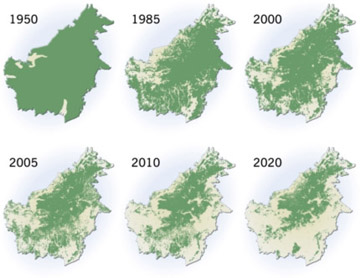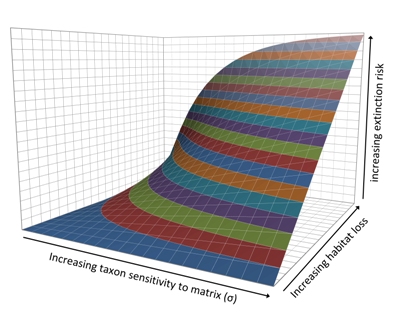.."One of the main differences between habitat islands and true islands is the intervening matrix," says Koh. By 'matrix', Koh does not mean an alternate reality where one can fight in slow-motion, but instead the type of landscapes in targeted areas, such as old-growth forests, secondary forest, small-scale agriculture, pasture, plantations, urban landscapes, and many others.
Figure 1: Extent of Deforestation in Borneo 1950-2005,

"In true island systems, the matrix is the ocean. It is quite reasonable to assume that most terrestrial organisms would not survive very well in this ocean matrix. The same, however, cannot be said of the matrix between habitat islands on a mainland because, in this case, the matrix could be a whole variety of land uses," Koh says, adding that "the main constraint of the conventional species-area model is that it assumes all organisms respond exactly the same to matrix (i.e. to be like an ocean)."
To answer this, Koh has developed a matrix-calibrated model that "takes account of the specific response of the organisms to each component of matrix". In other words Koh's model combines habitat loss with a species' sensitivity to surrounding matrices to determine the likelihood of extinction.
 The matrix model. |
"The winner would be the model that produced predictions that were closest to actual known bird extinctions or endangerment," Koh said.
The matrix model took first prize. "I found that the matrix-calibrated model was the best model among all models considered, and it was 13.5 times more strongly supported by the data than the conventional model," Koh says. The countryside model proved least accurate of the three, while the conventional model overestimated extinction in 18 of 20 of the hotspots—not surprising since this model assumes all habitats outside of forest are unlivable which may be true for some species but hardly all.
"While erring on the side of caution may be desirable from a strict conservationist perspective, I believe that is a less tenable position nowadays, given that donors to conservation causes and the general public are expecting more accurate prognosis of environmental ills, and are less tolerant of environmental blackwashing," Koh says. "Also, given increasingly limited conservation resources, it is invaluable to be able to accurately target them where most needed."
To begin helping conservationists immediately, Koh has built a working matrix model on-line called the Species Extinction Calculator. The calculator measures up to three different matrices, as well as allowing conservationists to tinker with the number of forest fragments and the edge effect. An additional Species Extinction Calculator—Multiple Landscapes allows one to measure the extinction rates in various forests and compare them. As well as being surprisingly addictive, the Species Extinction Calculator is an incredibly useful tool for saving species.
Please read more by Jeremy Hance at Mongabay
Comment:
I wounder if the "random matrix theory" could also deepen the vast toll a loss of one extinction has on all others?